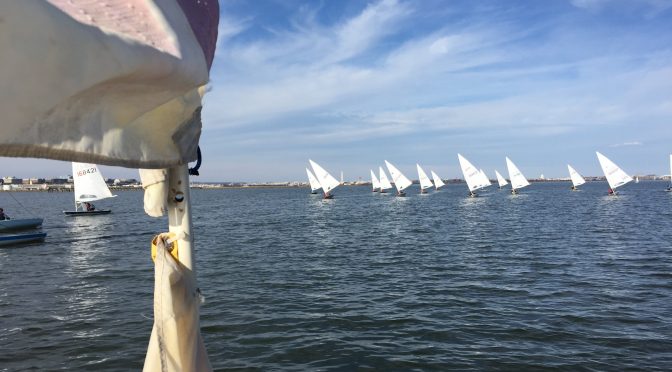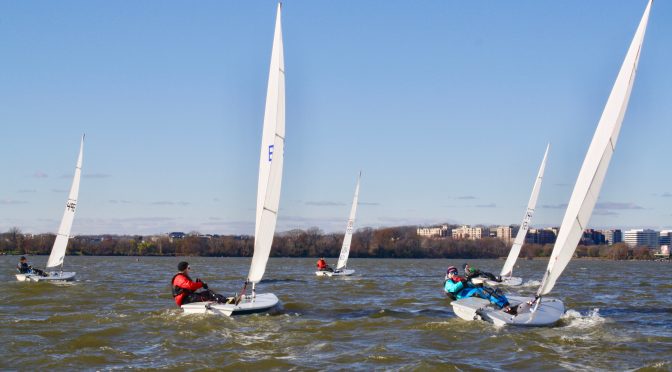Hi everyone,
All posts by Farley Will
2021 Hangover Regatta
Hangover Regatta this year was a little wet and cold but still 11 boats persevered!
2020-2021 Laser Frostbite Series #5
Dear fellow frost biters,
December 20 proved yet another beautiful race day run by our two grownups, Jim and Jacob. Short up-down courses and a short starting line provided abundant thrills and excitement in the first few races. After a couple of general recalls, J&J released the pressure on us with a longer start line and an Olympic course that calmed the mark roundings. A big thanks to J&J for an excellent set of varied races!
A few Annapolis exiles joined us again bringing new blood and adding to the vibrant racing. Thanks to whoever invited them and a warm welcome to our visitors and newcomers.
It seems tradition to reflect on sail trim. Many of you already know I’m back on the water after more than a couple of decades as a landlubber, and my last few pre-landlubber years were in a 27 ft keelboat (h-boat) with very different trimming. I think I’ve done well because of starts and other factors, so with weak confidence to advice on Laser trim, here’s what I was working on in the light wind.
Downwind: no cunningham, outhaul provided for a deep sail curve by the boom. I trimmed the kicking strap to where there is just enough control of the leech/twist, and I sometimes tightened it during puffs. I’m still trying to figure out how to sheet relative to the wind – a vane is on my list to Santa.
Upwind: clearly the combination of sheeting and the kicker is the key, no kicker is always too little, and with more wind, more is needed, but I haven’t figured out the balance. I play with it a lot. I usually find myself sheeting more loosely than others. I use very little cunningham if at all, and the outhaul is trimmed with the sail ~4-5 inches from the boom and only marginal variation.
Starts: I felt I did very well starting on the port end of the line as close to the mark as possible. After the tide turned, I thought it was better to be farther east, where I think the current is stronger, but I’m not really sure. Especially after we got a bit more space on the start line, rather than waiting in a promising spot, keeping moving around with some boat speed before the start seemed to allow me to find a good spot and cross the line with some momentum.
All in all another great day in the series, and I look forward to more. Until then, my best wishes for the holidays!
Thanks to Farley, the race results are attached
All in all another great day in the series, and I look forward to more. Until then, best wishes for the holidays!
2020-2021 Laser Frostbite Series #4
I was afraid going into the last race yesterday that this might be my fate.
Well actually I was pretty pleased.
Arriving at the dock at 11, it looked the westerly breeze had nearly died. As we got out to the race course, the northerly shift arrived and started filling in. In the first 2 1/2 races, the right side was strongly favored. In the first three races I got out to the right early, and was at or near the front at the first mark each race. The wind started shifting left in the middle of the third race and several boats who took the chance did well.
The wind shifted fairly strongly to the left at the end of the race, leaving the starting pin strongly favored. So I worked hard to get port tack starts for the last three races. In races 4 and 6 I missed the front hole, and had to cross some sterns. I was actually over early in race 4, and went around the pin, but was able to find a nice lane and clear air. In race 5, I was right on the line, and only “let” Tom pass me at the last leward mark. I still haven’t figured out how to do everything one needs to do down there.
Best thing on the day for me was being able to see where the wind was and get there. Worst thing is still that leward mark rounding.
Thanks to Farley for doing RC solo.
John Van Voorhis
2020-2021 Laser Frostbite Series #3
Hello Sailors,
2020-2021 Laser Frostbit Series #3
Photo Credit to Kaitlyn Lucey
2020-2021 Laser Frostbite Series #2
Thanks to Jim Klein for providing a seamless solo RC experience.
2020-2021 Laser Frostbite Series #1
Third Place Write Up (Jim Klein) 11/22/2020
Hello Everyone,
Thank you Tom Hutton doing the RC for us on this first week of our frostbite series. Despite being alone in the RC boat you managed to give us Olympic, WL and Triangle races to keep things interesting, as well as maintaining a square start line.
My boat was set up the following way:
Vang: On fairly tight upwind, but not so tight that I had to worry about hitting my head on the boom during tacks. Offwind pretty far off, but always cleated down. You don’t want to have the vang completely loose or else the whole sail structure is loose, moves around too much, and generally sucks up energy of the boat rocking back and forth. Rather, you want that rocking energy to be translated to forward motion. Think rigidity in the whole boat/mast/sail structure.
Outhaul: About 4” off the boom at mid point.
Cunningham: Off and completely loose.
Mainsheet: Two blocked upwind during the windier times, else about 5” between the aft blocks.
Starts: No one side was favored enough to attempt starting on that particular side. I felt it was more important just to have good speed at the gun. I would often try to start on port and in the last 20 seconds or so, look for a hole in the fleet so I could tack and be on starboard tack at the gun. But this did not always work out so well; in one race, I could not find any hole and had to let the entire fleet cross the line before I squeezed in finally at the boat end. Interestingly, that was the one race where I went out way to the right (on port tack) and somehow got some favorable wind so that I could pass just about the whole fleet by the windward mark. That was more luck than planning. The first 15 seconds after the gun are critical for you to get out in front as much as you can. This is no time to be playing with sail controls, but rather to be focused completely on getting ahead of those around you.
Upwind: In the first several races I had a helmet on (and covid mask), and it was preventing me from feeling the wind shifts. Then I took all those off and did better because I could feel the wind better with my head and face. I would tack pretty often when I detected a wind shift. I tried to be careful never to let the mast come beyond 90 degrees to the water. That meant moving around a lot on the boat.
Downwind: I tried to keep air flowing over my sail, even if that meant sailing in more of an “S” shape path rather than a straight line to the mark. That means, when the wind dies off, try to head up a bit from a run to a broad reach, and focus on keeping the air attached to your sail and telltales flying back. Then if the wind would come back in strength, I would again go back to a dead run. In some cases, it was very advantageous to sail by the lee. I also tried as much as possible to get my weight all the way forward and to heel the boat so the sail sticks up in the air as much as possible.
2019-2020 Laser Frostbite Series #16
Writeup to Come
2019-2020 Laser Frostbite Series #15
2019-2020 Laser Frostbite Series #14
– boom Vang tension upwind. A number of folks are sailing with loose Vang tension upwind. Even when it is relatively light air I suggest you keep at least a snug Vang. In really light air I actually put on a good bit of Vang to induce bend in the mast to flatten the sail. As the wind builds from around 4-6 knots I I will loosen it a bit but the Vang will never have slack in it. As the winds builds beyond that I will continually add more Vang to flatten the sail.
– traveler block A number of folks were sailing upwind with their traveler block too far inboard. Often that is a sign that your traveler line is too loose. If I see my traveler block is not all the way outboard I will ease my sail a few inches to encourage it to get further out before trimming it right back in.
– boom angle downwind. Sailing by the Lee is really fast in a laser, but a lot of people sail with their boom too far out. Remember that your leech falls off far beyond your boom angle, so if your boom is eased beyond 90 degrees, let’s say it’s hypothetically 110 degrees, your leach is probably somewhere around 125 degrees. In light air having the boom beyond 90 is okay, but not way beyond (unless you are purposely trying to move across the wind for a tactical situation). As the wind builds, you want to bring the main back in to 90 degrees and when it is windy, in a lot more than that. Did you flip (or almost flip) recently when a gust came down the course from behind? That could be a clue that you are sailing with the main too far out. It is hard to tell when your main is at 90 degrees, but what I find helpful is a mark or piece of tape on my mainsheet that tells me when the boom is at 90. I use that as a reference to adjust from. The other critical adjustment downwind is Vang tension. A good way to tell if you have your Vang tension right downwind is to watch the leach of your sail. You want a lively leach, meaning it should bounce a bit when you hit waves or when you get puffs. If it is too rigid you have to much vang. If it is falling off to leeward and never bouncing back, you have it too loose.
– turning the boat around the weather mark. Getting quickly away from the weather mark is a big help when you are next to other boats. Many people lean in as they come to the mark to ease their Vang, outhaul, and Cunningham. The trouble is that leaning in causes the boat to heal to leeward, which makes the boat want to head up not down. To compensate, most people will use their rudder to steer the boat down, which creates huge amounts of drag (slow). A better approach is to ease your control lines before getting to the mark (Vang is most important). As you get to the mark hike out and lean back, which will shift the center of lateral resistance and cause your boat to turn sharply downwind. Due this as you ease your sheet and you will escape quickly from the mark.


